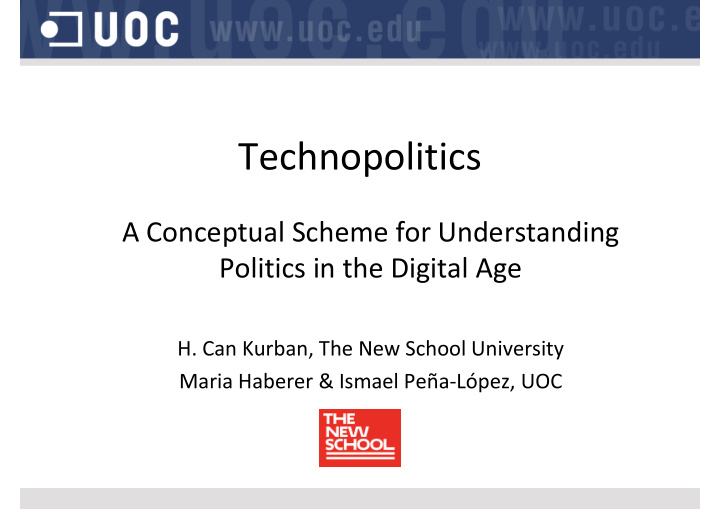



Technopolitics A Conceptual Scheme for Understanding Politics in the Digital Age H. Can Kurban, The New School University Maria Haberer & Ismael Peña ‐ López, UOC
Internet and Politics • ICTs as isolated external variables • Online vs offline? • Internet = Democracy? • ICTs � Government 2.0? • The Question of Power and Legitimacy • Paradigmatic Change in 2008 2 Background of the Topic
Technopolitics Outline • Context • Actors • Scale • Direction • Synchronization • Purpose
Technopolitics Literature • “constitutional integrity” (Lebkowski, 1997) • “hybridity” (Hecht, 2001) • contingency and multiplicity of actors (Kellner, 2001) • contesting conceptions of citizenship, rights, and the polity (Hughes, 2006) • the closed vs. the open (Rasmussen, 2007) • power and strategy (Toret et al. 2015) 4 Literature Review
Conceptual Focus The Origins of Antagonism: • The Organizing Role of Communication (Internet Governance) • The Value of Information (Big/Public Data) 5 Two Main Concepts
Technopolitics Battles • Post ‐ 2008 Context and Actors 6 Major Contestations
Context – Contentious Politics • New Digital Media Environment (Chadwick, 2009) • Organizational change (Bimber et. al, 2012) – Resource mobilization – Participation – Collective Action Pattern: networked practices travel from micro level individual behaviours and expectation) to meso level (collective action, campaigning, co-framing) 7 Contentious Politics in post ‐ 2008 context
Scale Individual => Organization => Contentious Networks The connective logic (Bennett and Segerberg, 2013) – Scale up more quickly – Produce large mobilization – Funding – Flexibility in tracking moving political targets, and bridging different issues – Build up adaptive repertoires, share open source software development, and embrace an ethos of inclusiveness. 8 Scaling Up
Direction Contentious Politics Moving From Outside to Inside the Institutional Politics Cases: Barcelona En Comu, Ahora Madrid, The Pirate Party in Iceland 9 Direction
Synchronization Internal • New spaces for activism (Barlow, Echeverría, Castels), including no- places (Augé) • Spaces that are not isolated, but behave as different layers of a same reality (Toret, Monterde) • There are "synchronization" practices across spaces that spread information and enable coordination of action (Corsín & Estalella, Martínez Roldán, Monterde) External • D-Cent Project 10 Synchronization
Purpose • Short term: take back politics – increasing civic engagement – taking the influence of big money out of politics • Long term: hack the political system – Change the existing processes – Expose its shortcomings 11 Purpose
Discussion • Synchronize across Europe? • Full Scalability? • A New Constitutional Process? 12 Discussion
Recommend
More recommend